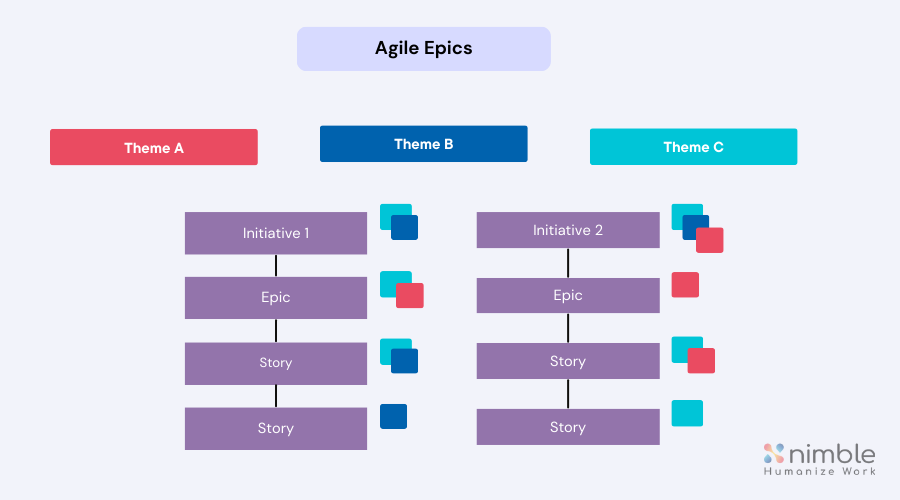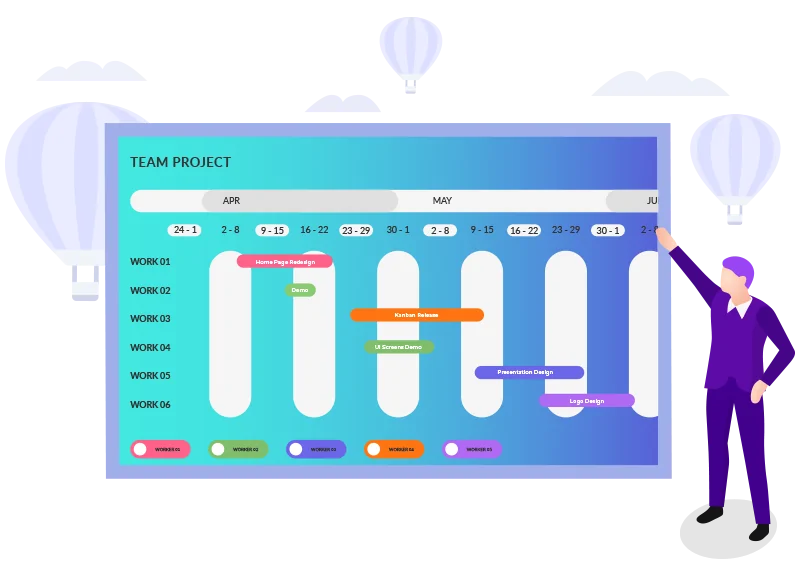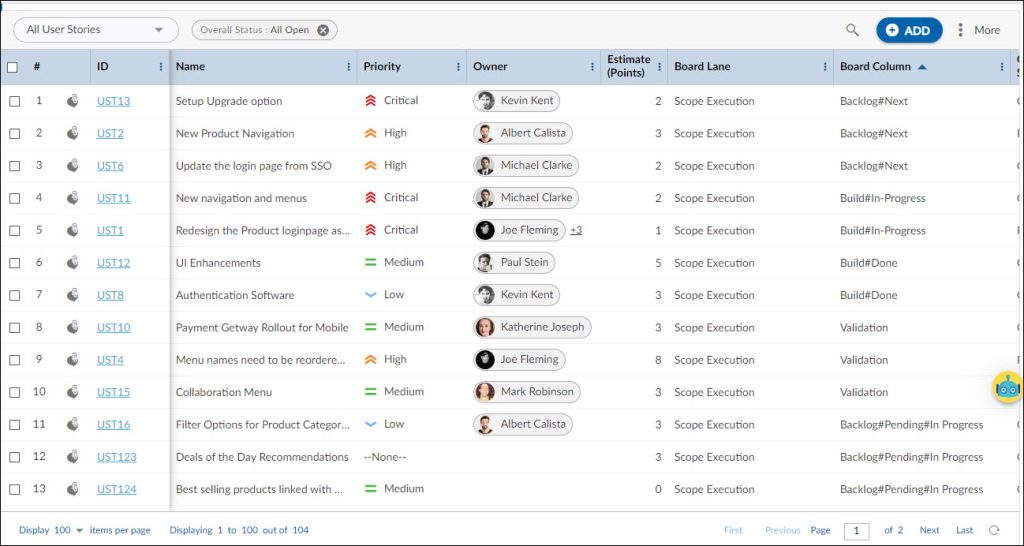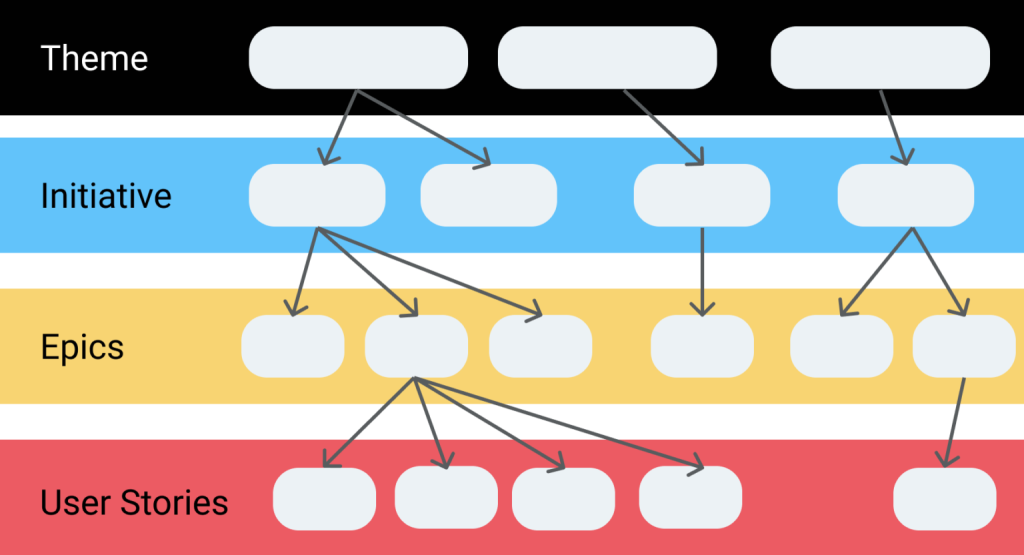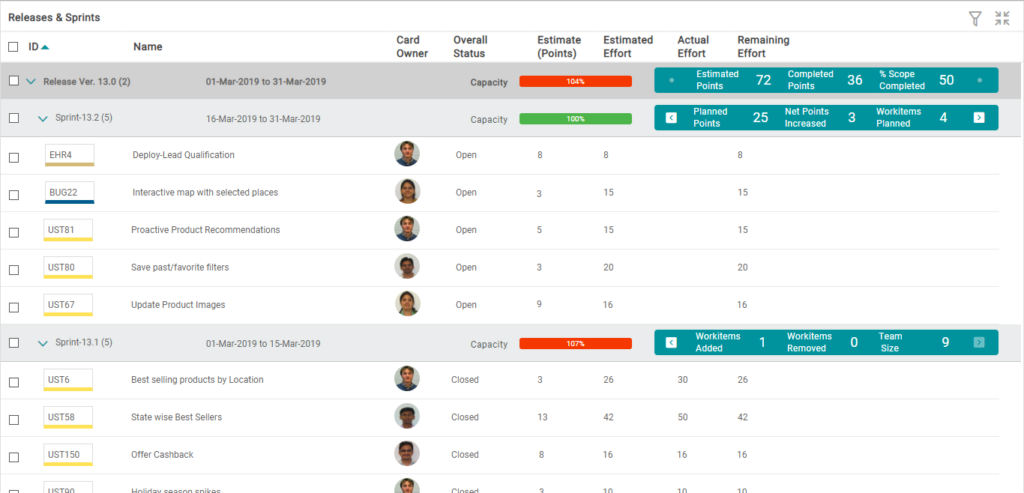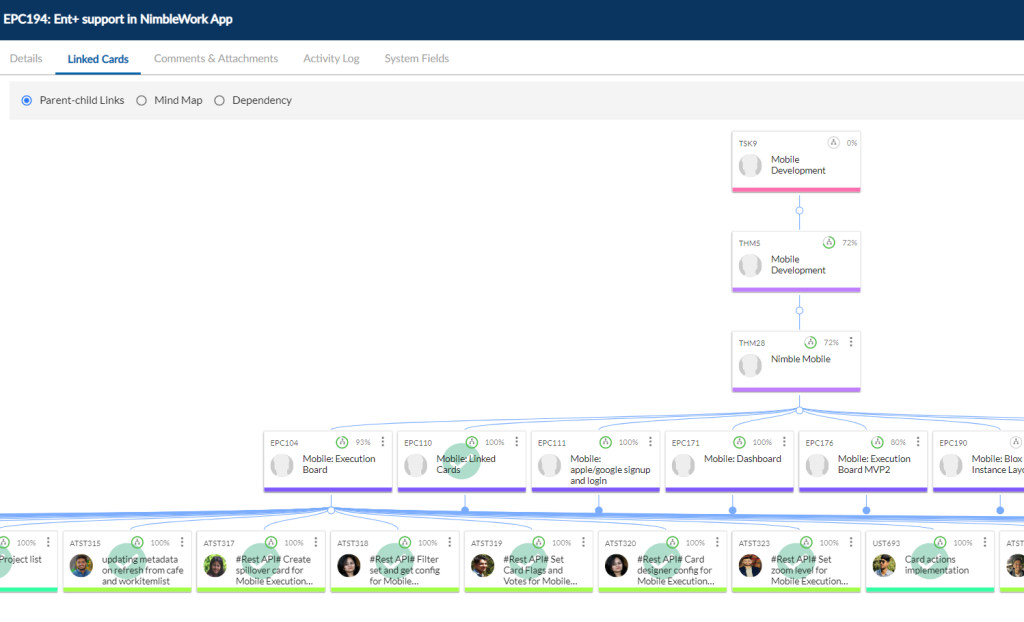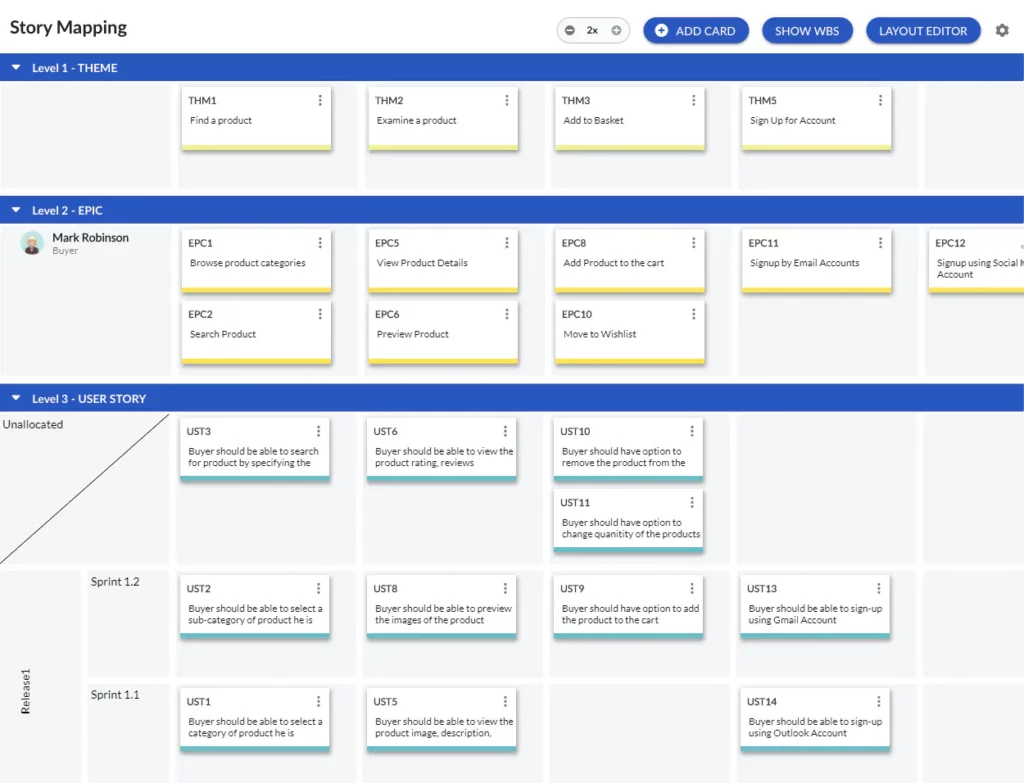What is an Agile Epic? Benefits of Using Them
- 11 mins read
-
By Bravin Wasike
- Updated on June 3, 2024
Navigate to
Agile development methodologies have revolutionized software development by emphasizing flexibility, responsiveness, and iterative delivery. Within this framework, Agile epics are essential in structuring large projects and ensuring efficient progress.
Agile epics break down the project into manageable sections and keep the long-term vision in sight.
This article will provide a comprehensive overview of Agile epics and their role in Agile project management.
What is an Agile Epic?
In Agile project management, an epic refers to a large body of work that can be broken down into smaller, more manageable tasks known as user stories. Epics are typically high-level requirements or features encompassing multiple user stories and representing significant functionality within a project.
Epics are characterized by their size, complexity, and strategic importance to the project. They are typically too large to be completed within a single sprint and may require collaboration across multiple teams or departments.
How Epics fit into the Agile Framework
In Agile project management, epics play a pivotal role in organizing and prioritizing work within the larger context of the project. They are part of a hierarchical structure that includes product roadmaps, themes, epics, user stories, and tasks each serving a distinct purpose in the Agile framework.
With some minor variations across organizations and different agile frameworks, there is a typical terminology associated with breaking down the scope of work into manageable chunks. Typically, these might be –
👉 Epics, User Stories (typical small Agile/ Scrum projects)
👉 Themes, Epics, User Stories (Scrum/ Kanban mid-sized or large projects)
👉 Epics, Capabilities, Features, User Stories (Scaled Agile large and very large projects)
In all cases, User Stories typically get done using a set of tasks which are the lowest planning and tracking unit for the purposes of effort and cost tracking. Many Agile teams have moved away from this and track their work at the User Story level only.
A typical Agile team using Scrum or Kanban or a mix might start with Epics and User Stories.
Here is an overview of the various elements mentioned above.
Project Roadmap
A high-level plan outlining the long-term vision and strategic goals for the product. It serves as a guiding document for future development efforts.
Theme
A broad category within the product roadmap that represents a strategic objective. It encompasses a collection of initiatives that contribute to achieving that specific goal.
Initiative
A larger piece of functionality or feature that contributes to a particular theme. It breaks down the theme into more actionable components.
Epic
A significant user story that represents a complex theme or functionality within an initiative. It’s too large to be completed within a single sprint but is further decomposed into smaller user stories.
Feature
A feature typically refers to a high-level functionality or characteristic of a product that delivers value to the end user. Features are often expressed in terms of user needs or requirements and are used to describe what the product should do from a user’s perspective.
Features in Agile are larger than user stories but smaller than epics. They represent a significant piece of functionality that can usually be implemented within a single iteration or sprint. Features are broken down into smaller, more manageable user stories during the Agile planning process.
Features serve as a way to prioritize and organize the work that needs to be done, allowing Agile teams to focus on delivering incremental value to the customer on time. They help teams align their efforts with the overall goals and objectives of the project while ensuring that the most important functionality is developed first.
User Story
A detailed description of functionality or feature from the user’s perspective and ideally achievable within a single sprint.
Task
The most granular unit of work required to complete a user story. Tasks represent the specific actions developers need to take to deliver the functionality outlined in the user story.
The following image show the hierarchical structure of agile project management:
Source: theproducthub.io
Comparison between Agile epics, User stories, and Tasks
Agile development relies on a hierarchical structure to manage projects effectively. The following is a comparison between Agile epics, user stories, and tasks:
Agile Epics
Agile epics are large bodies of work that encompass significant features or initiatives within a project. They represent high-level requirements that may span multiple sprints or releases.
Epics cover broad areas of functionality or business needs and provide a strategic roadmap for the project. They serve as placeholders for large-scale initiatives and help prioritize work based on strategic goals and objectives.
Example of an Agile Epic: “Develop a mobile app for online banking” could be an epic encompassing various features such as account management, transaction history, and bill payments.
User Stories
User stories are small, concise descriptions of a specific feature or functionality from an end-user perspective. They capture the requirements and acceptance criteria necessary to deliver value to the customer.
User stories focus on one specific aspect of functionality or user need and are typically completed within a single sprint (typically 1-4 weeks). They provide detailed, actionable plans for implementation and help prioritize work based on customer value.
Example of a user story: “As a user, I want to view my account balance so that I can keep track of my finances” is a user story that describes a specific feature of the online banking app.
Tasks
Tasks are individual actions or activities that need to be completed to fulfill the requirements outlined in user stories or epics. They are granular and specific, representing the smallest unit of work within the Agile framework. They can be completed within hours or days.
Tasks break down user stories or epics into actionable items and guide the day-to-day work of the development team.
Example of a task: “Develop database schema for user accounts” or “Write unit tests for account balance feature” are examples of tasks associated with the user story or epic related to account management.
Deciding what elements you need in your Product Backlog
Determining the elements to include in your product backlog is a crucial step in effectively managing your project or product development. Understanding the role of each element within the Agile framework and how they relate to each other is essential for successful planning and execution.
Depending on the overall size of your project or product, you can decide how best to break down your project or product scope into manageable pieces. If you are unsure where to start, you can start at the basic level of breaking down the overall scope into several Epics. You might have a dozen epics in a 4-6 month project – but it all depends on your context – there’s no hard and fast rule for it.
This can also depend on your “release cycle” – how often you would like to deliver something of value to your final customer. This could be a Release once a quarter (most common) or it could be more or less frequent depending on the nature of your business. High-tech digital product and services companies such as Facebook or Netflix might do daily releases, whereas a regulatory or healthcare company might do it once or twice a year.
Typically, an Epic might span several Sprints (2-3 week cycles) – and is completed within a Release Cycle. One Release might include 3-5 Epics. Each Epic can have multiple Features that break into User Stories.
Understanding the role of epics within the Agile framework and their relationship to other backlog elements is essential for effective backlog management. Epics provide a strategic view of the product roadmap, guide release, and sprint planning, and ensure that development efforts are aligned with business objectives
Defining and Managing Epics in Agile Software Development
In Agile software development, Epics serve as essential planning elements, guiding the direction of development efforts and shaping the product roadmap. However, understanding how to effectively identify, define, and manage Epics is crucial for successful project execution.
Let’s cover the key considerations and best practices for handling Epics in Agile development.
Identifying and Defining Epics
The first step in managing Epics is identifying them within the context of your project. Epics represent large, high-level features or initiatives that cannot be completed within a single sprint.
When identifying Epics, consider the following questions:
👉 What are the major components or functionalities of the product?
👉 Are there any significant user journeys or workflows that need to be addressed?
👉 What are the overarching goals and objectives of the project?
Once identified, it’s essential to define each Epic clearly, outlining its scope, objectives, and requirements. This involves collaborating with stakeholders, including product owners, developers, and end-users, to ensure a comprehensive understanding of Epic’s purpose and desired outcomes.
Describing the Scope and Requirements of an Epic
When describing the scope and requirements of an Epic, focus on capturing the key deliverables and functionalities it encompasses. This may include both functional and non-functional requirements, such as performance, scalability, and security considerations.
To effectively define an Epic, consider the following elements:
1. Scope Definition
Clearly outline the boundaries and objectives of the Epic to establish its scope. Define what the Epic aims to achieve and the problem it addresses within the context of the project or product.
2. Objective Identification
Identify the specific goals and outcomes that the Epic is intended to accomplish. These objectives should be aligned with the overall project goals and contribute to fulfilling the needs of the end-users or customers.
3. Functional and Non-functional Requirements
Document both functional and non-functional requirements of the Epic. Functional requirements define the specific features and functionalities that Epic will deliver, while non-functional requirements address aspects such as performance, security, and scalability.
4. Acceptance Criteria
Define the criteria that must be met for the Epic to be considered complete and ready for release. Acceptance criteria provide clear guidelines for evaluating Epic’s implementation and ensure that it meets the expectations of stakeholders.
5. Dependencies and Constraints
Identify any dependencies or constraints that may impact the implementation of the Epic. This includes dependencies on other Epics or external factors that may influence the Epic’s scope or timeline.
Breaking Down Epics into Features and User Stories
Once Epics are defined, they need to be broken down into smaller, actionable items that can be implemented within a single sprint. This typically involves decomposing Epics into Features and User Stories, which represent specific, testable units of work.
1. Defining Features
Features represent distinct components or functionalities of the software that contribute to achieving the objectives outlined in the epic. Each feature should be independent and deliver value to the end user. Features provide a mid-level granularity between epics and user stories, allowing teams to organize and prioritize work more effectively.
Examples of Features
– User Authentication: Implementing a secure login system for users to access the application.
– Payment Processing: Integrating payment gateways to enable users to make purchases within the application.
– Search Functionality: Implementing a search feature to allow users to find relevant content or products.
2. Creating User Stories
User stories are granular, actionable tasks that describe a specific piece of functionality from the perspective of the end user. Each user story should follow the INVEST criteria (Independent, Negotiable, Valuable, Estimable, Small, Testable) and be small enough to be completed within a single sprint. User stories typically follow the “As a [role], I want [goal], so that [benefit]” format to capture the user’s perspective, the desired outcome, and the value it provides.
Examples of User Stories
– As a user, I want to log in to the application using my email and password, so that I can access my account securely.
– As a customer, I want to add items to my shopping cart and proceed to checkout, so that I can purchase products online.
– As a site visitor, I want to search for products by keyword, so that I can find relevant items quickly and easily.
Challenges in Defining Epics
While epics serve as valuable tools for organizing and prioritizing work in Agile development, defining them effectively can pose several challenges for teams. Overcoming these challenges is essential to ensure that epics accurately reflect the strategic objectives of the project and align with the needs of stakeholders. The following are some common challenges in defining epics:
1. Lack of Clarity on Scope
One of the primary challenges in defining epics is a lack of clarity on the scope and boundaries of the work they encompass. Without a clear understanding of the strategic objectives and desired outcomes, teams may struggle to define epics that effectively address the needs of stakeholders.
2. Balancing Granularity
Finding the right level of granularity for epics can be challenging. Epics should be large enough to represent significant pieces of work that deliver value to the end user but not so large that they become unwieldy or difficult to manage. Striking the right balance between granularity and manageability is key to defining effective epics.
3. Managing Dependencies
Epics often involve complex interdependencies with other components of the system, including features, user stories, and external dependencies. Managing these dependencies and ensuring that epics can be completed on time requires careful coordination and communication among team members.
4. Aligning with Business Objectives
Epics should be aligned with the overarching business objectives of the project or product. However, achieving this alignment can be challenging, particularly in large and complex organizations where multiple stakeholders may have competing priorities. Ensuring that epics contribute to the strategic goals of the project requires ongoing collaboration and alignment among stakeholders.
5. Estimating Effort and Complexity
Estimating the effort and complexity of epics is another common challenge. Without accurate estimates, teams may struggle to prioritize epics effectively and allocate resources appropriately. Estimation techniques such as relative sizing, story points, or planning poker can help teams assess the effort required to complete each epic and make informed decisions about prioritization.
6. Evolving Requirements
Finally, evolving requirements can present challenges in defining epics. As the project progresses and stakeholders gain a deeper understanding of their needs, epics may need to be refined or adjusted to reflect changing priorities or emerging opportunities. Flexibility and adaptability are essential for effectively managing evolving requirements and ensuring that epics remain aligned with business objectives.
Best Practices of Defining, Managing, and Delivering Epics
Implementing Agile epics effectively in software development projects requires an approach that encompasses not only their definition but also their management and delivery. To ensure successful project outcomes, it’s crucial to consider a comprehensive set of best practices that address various aspects of epic implementation. To maximize the effectiveness of Agile epics, consider the following best practices:
👉 Clearly Define Epics: Ensure that epics are well-defined, with clear objectives, acceptance criteria, and success metrics.
👉 Prioritize Epics Strategically: Prioritize epics based on their strategic importance, business value, and dependencies to ensure that resources are allocated effectively.
👉 Break Down Epics Thoughtfully: Collaboratively break down epics into smaller, manageable user stories that can be completed within a single sprint or iteration.
👉 Monitor Progress Continuously: Regularly review and update epics to track progress, identify risks, and make informed decisions based on real-time data.
👉 Estimate and Plan: Estimate the effort, time, and resources required to complete each epic and its associated user stories. Use techniques such as story points or relative sizing to estimate the complexity of work items accurately.
👉 Consider Epic Sizing: Take into account the size and scope of each epic, considering both functional and technical aspects. Ensure that epics are sized appropriately to balance the need for meaningful progress within a single release while accommodating complex or large-scale features.
👉 Plan Development Across Releases: Plan the development of epics across one or more releases, adopting a phased approach to implementation. Break down epics into smaller, releasable increments to deliver value incrementally and allow for iterative feedback and refinement.
👉 Address Function and Technical Aspects: Consider both functional and technical/non-functional aspects when defining epics. Balance functional requirements with technical requirements to ensure that epics deliver value to end users while meeting performance, scalability, security, and other technical requirements.
Takeaway
Agile epics play a fundamental role in Agile project management, serving as essential components for scope breakdown, backlog creation, and overall project planning. Epics serve as a means to break down complex requirements into manageable pieces, prioritize work based on value and strategic importance, and align development efforts with overarching business goals. Through understanding the practical function and purpose of Agile epics, teams can streamline their development processes, foster collaboration, and deliver tangible value to stakeholders.
How to manage epics with Nimble Agile?
As demonstrated, epics serve as a valuable asset for Agile teams, allowing for the grouping of user stories to facilitate focused prioritization and incremental value delivery.
Nimble offers a range of robust features that empowers teams to efficiently organize product backlogs, strategize sprints, and prioritize epics. Nimble Agile enables organizations to fully utilize the benefits of Agile project management, resulting in significant value delivery.
Signup for a free trial of Nimble Agile.
About Author:

Agile 101
What is an Agile Epic? Benefits of Using Them
Learn what an Agile epic is, how it can streamline project management, and the benefits of incorporating epics into your Agile workflow.
Is Hybrid Agile Right for your Team? Here’s what you need to know
Explore the suitability of Hybrid Agile for your project needs in our comprehensive article. We delve into the benefits, considerations, and key factors to help you determine if this approach aligns with your organization’s goals and project requirements.
What is Hybrid Agile Project Management? A Short Guide
Discover the power of Hybrid Agile project management: achieve flexibility and structure for successful project execution. Learn how to harness this dynamic approach.
Dynamic System Development Method (DSDM)
Dynamic Systems Development Method, DSDM for short, seeks to do what came to be known as ‘Agile’ well before the manifesto was written. Learn more about its philosophy, principles, pillars, and practices.
What is Scrum Methodology? An Introduction for Agile Teams
Scrum is an agile project management framework that prioritizes collaboration and iterative development for efficient results.
Scrum of Scrums: A Starting Point to Scaling Agile
Scrum of scrums is an approach to coordinate multiple scrum teams working together. Learn how it works, how to get started and how it differs from competing approaches.
Pair programming is a programming method in which two people work together on a single program. The first person is the “Driver”, who writes the code, the other person is the “Navigator” who reviews each line of code as it is typed, checking for errors. They exchange their roles on a regular basis.
Code refactoring in Agile is a well-known technique to keep a codebase healthy and amenable to change. Learn what it is and a sound process to follow.
Speed up your Agile planning and execution!
Signup for a FREE Trial of Nimble Agile



